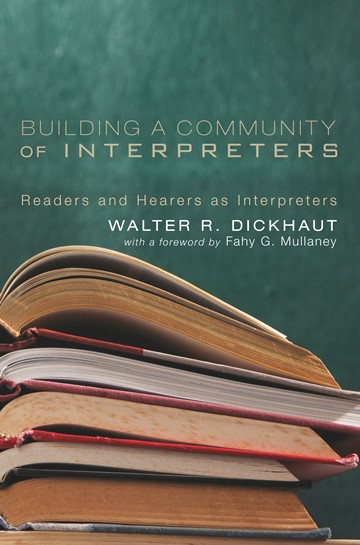Walter Dickhaut: Building a Community of Interpreters
 Walter R. Dickhaut, Building a Community of Interpreters: Readers and Hearers as Interpreters (Eugene, Oregon: Cascade Books, 2013) 125 pages, ISBN 9781610979962.
Walter R. Dickhaut, Building a Community of Interpreters: Readers and Hearers as Interpreters (Eugene, Oregon: Cascade Books, 2013) 125 pages, ISBN 9781610979962.
Walter R. Dickhaut, in his small volume, Building a Community of Interpreters: Readers and Hearers as Interpreters, proposes that listeners and hearers of a sermon, story or biblical text function as interpreters of the meaning of each of these types of expression or forms of communication. Dickhaut’s thesis maintains that the hermeneutical process is better perceived as a spiral, rather than a circle with a closed circuit, because the reader of any text can influence its interpretation (12).
Dickhaut presents his proposal in two parts. The chapters in part one explain the process of listening, which involves the numerous occasions when one meets the text, the particular angle of vision of the reader and the metaphorical filters and lenses applied in each hearing. Every time a reader encounters or meets the same text, it is not the same reader who encountered the text previously (18). Time and the circumstances of the reader have changed. He may have acquired new learning or modified certain perspectives (18). A filter applied by a reader or listener removes what the reader prefers not to engage (21). The reader is often unaware the presence of these filters. Information that does not conform to the reader’s beliefs or opinions is filtered out. Dickhaut wants the reader to be aware he is wearing these unexpected blinders in the form of biases and prejudgments. When mindful of the blinders, the reader is better able as to make appropriate adjustments (25).
Lenses, on the other hand, focus the listener’s attention on specific interests and features that aim to discover something new (21-22). Lenses empower interpreters to discover “mystery, surprise, and expectation” in biblical texts (34). Lenses function to enhance or enlarge certain details (22). The reader’s angles of vision also shape interpretation. Angles of vision are shaped by the listener’s personal experience, family history, theological and political positions and social and cultural location (27).
The second part, chapters seven through fourteen, is an expanded discussion on the lenses of
mystery, surprise, and expectation, punctuated with three of the author’s sermons. The author encourages the reader to view texts through the lens of mystery and read and listen in such a way that he is satisfied with a sense of the mystery of God rather than needing explanation and rationalization. To read with expectation is to read and listen as one dissatisfied with certain aspects of the world we inhabit (86-87). Surprise in a biblical text can be achieved by searching for things one does not understand, because in doing so the reader “is more likely to learn something new, something that surprises him” (67).
The book’s strength is its reflection on the various factors that potentially effect the listener’s interpretation of a sermon or biblical text. Thus, preachers and teachers are introduced to features that influence the listener’s interpretation of a text or sermon. The author delivers on his goal to encourage building a community of interpreters. In the Afterword, Dickhaut maps out sessions for a Bible study group that explores what happens to meaning when a reader opens a book or listens to a sermon from various angles and when wearing a variety of spectacles.
Reviewed by David Seal
Publisher’s page: http://wipfandstock.com/building-a-community-of-interpreters.html
Preview Building a Community of Interpreters: https://books.google.com/books?id=YkxNAwAAQBAJ
Category: Biblical Studies, Summer 2016


